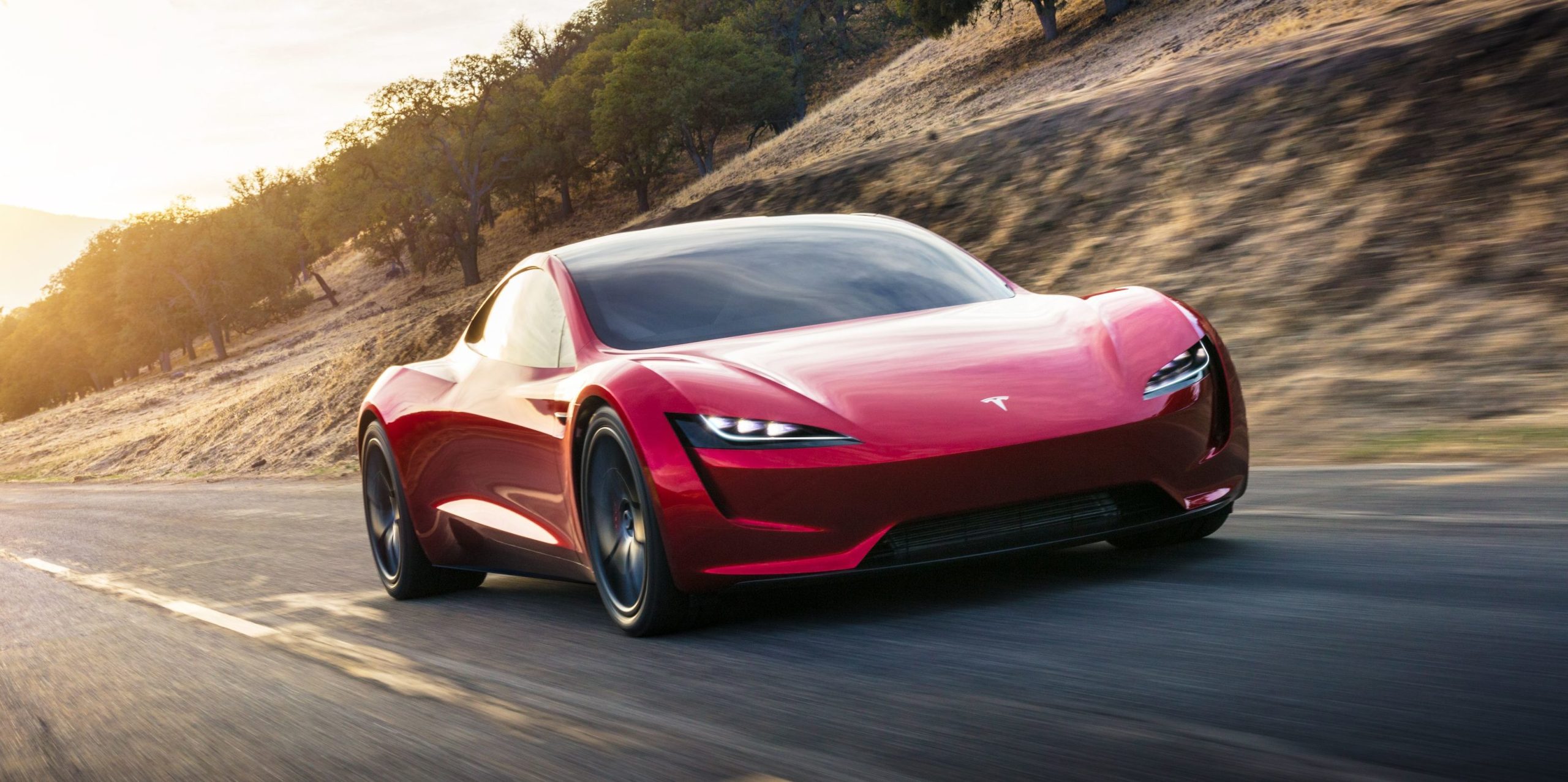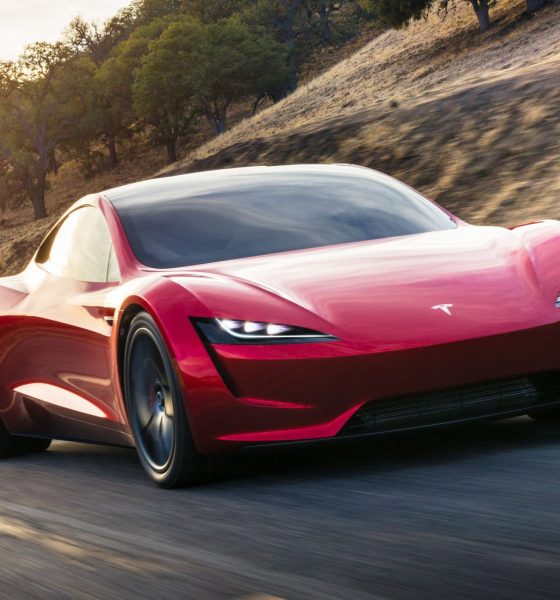

News
Tesla Roadster performance specs are actual and not theoretical, says test driver
Emile Bouret, the man behind the wheel of the next-gen Roadster during the vehicle’s test drives last November, recently called on all car enthusiasts to support the upcoming all-electric supercar. According to the veteran test driver, vehicles like the next-generation Roadster have the potential to make the automotive world a “better place,” considering that it would likely trigger a race to make cars that are even more impressive.
Bouret has worked with Tesla since the company’s early days. A close friend of Tesla chief designer Franz von Holzhausen and a 28-year veteran of the auto industry, Bouret has been asked to test drive the electric car makers’ vehicles from the original Tesla Roadster and the Model S. During his interview with YouTube’s VINwiki channel, Bouret admitted that he does not really understand the hate being directed towards the next-gen Tesla Roadster.
“I love that I live in a world where all these cars exist. You have Koenigseggs and Paganis and Ferraris and Lamborghinis and McLarens and Porsches and Rimacs and Teslas. So, I know there’s a lot of hate out there, but I just don’t understand it. If you’re a car person, wouldn’t you root for everybody? I’m definitely rooting for them because the world will be a better place if that car does get built and it gets on the road, because other people are gonna build cars to beat it — and we’re gonna win.”
The next-generation Tesla Roadster gave the auto industry a massive surprise when Elon Musk unveiled the vehicle last November. The all-electric supercar’s claimed specs, after all, including its 0-60 mph time of 1.9 seconds, it’s quarter-mile time of 8.8 seconds, and its range of 620 miles per charge, have caused some controversy among conventional car enthusiasts. Among the most prominent points of skepticism include speed limitations because of the vehicle’s tires, as well as battery technology that is yet to be attained.
Tesla, however, has assured that the specs announced for the next-gen Roadster are actually conservative. According to Bouret, the upcoming all-electric supercar’s figures related by Elon Musk were not theoretical. They were the actual numbers that their tests have shown.
“Those aren’t theoretical. Those aren’t calculations. We’ve done those numbers. And I probably shouldn’t say that those numbers are even conservative, but they are. That thing is going to be a proper weapon,” he said.
The pervading doubts cast on the next-generation Tesla Roadster’s speed and range are understandable, considering that no other vehicle on the road today boasts comparable specs and performance. Over the past few months, however, Tesla has been dropping hints that the company does have all the necessary resources it needs to attain, or even surpass, the vehicle’s specs that were announced last November.

A white next-gen Tesla Roadster makes an appearance during the 2018 annual shareholders meeting. [Credit: Dennis Pascual/Twitter]
Just last month, for example, Elon Musk openly discussed the idea of using some of SpaceX’s technology to augment the performance capabilities of the next-generation Tesla Roadster. According to Musk, the upcoming supercar would use Composite Overwrapped Pressure Vessels (COPV), which are used by SpaceX’s Falcon rockets during re-entry and landing, to help the car’s acceleration and maneuverability. As we noted in a previous report, the seemingly outlandish idea is actually feasible.
As for the next-gen Roadster’s battery technology, Tesla CTO JB Straubel discussed it best during the company’s Q1 2018 earnings call. While addressing a question about the Tesla Semi’s range, Straubel noted that much of the doubts behind the company’s estimated range for its vehicles comes from a misunderstanding of the company’s battery tech.
“I think the key point is that it doesn’t require a dramatic breakthrough. So there’s a fundamental misunderstanding, I think, of what the current technology in our existing products can actually do. If they’re benchmarking sort of the best battery pack they can buy from a supplier, and then mapping that with what the Semi could do, it doesn’t solve. I think that’s maybe where most of it is coming from, but we basically have what we need in-house, and understand how to do those specs today,” Straubel said.
The next-generation Tesla Roadster is expected to enter production sometime in 2020. Test drives for the vehicle are expected to begin late next year.
Watch Emile Bouret’s discussion of the next-generation Tesla Roadster in the video below.

News
Tesla China delivery centers look packed as 2025 comes to a close
Needless to say, it appears that Tesla China seems intent on ending 2025 on a strong note.

Tesla’s delivery centers in China seem to be absolutely packed as the final days of 2025 wind down, with photos on social media showing delivery locations being filled wall-to-wall with vehicles waiting for their new owners.
Needless to say, it appears that Tesla China seems intent on ending 2025 on a strong note.
Full delivery center hints at year-end demand surge
A recent image from a Chinese delivery center posted by industry watcher @Tslachan on X revealed rows upon rows of freshly prepared Model Y and Model 3 units, some of which were adorned with red bows and teddy bears. Some customers also seem to be looking over their vehicles with Tesla delivery staff.
The images hint at a strong year-end push to clear inventory and deliver as many vehicles as possible. Interestingly enough, several Model Y L vehicles could be seen in the photos, hinting at the demand for the extended wheelbase-six seat variant of the best-selling all-electric crossover.
Strong demand in China
Consumer demand for the Model Y and Model 3 in China seems to be quite notable. This could be inferred from the estimated delivery dates for the Model 3 and Model Y, which have been extended to February 2026 for several variants. Apart from this, the Model Y and Model 3 also continue to rank well in China’s premium EV segment.
From January to November alone, the Model Y took China’s number one spot in the RMB 200,000-RMB 300,000 segment for electric vehicles, selling 359,463 units. The Model 3 sedan took third place, selling 172,392. This is quite impressive considering that both the Model Y and Model 3 are still priced at a premium compared to some of their rivals, such as the Xiaomi SU7 and YU7.
With delivery centers in December being quite busy, it does seem like Tesla China will end the year on a strong note once more.
News
Tesla Giga Berlin draws “red line” over IG Metall union’s 35-hour week demands
Factory manager André Thierig has drawn a “red line” against reducing Giga Berlin’s workweek to 35 hours, while highlighting that Tesla has actually increased its workers’ salaries more substantially than other carmakers in the country.

Tesla Giga Berlin has found itself in a new labor dispute in Germany, where union IG Metall is pushing for adoption of a collective agreement to boost wages and implement changes, such as a 35-hour workweek.
In a comment, Giga Berlin manager André Thierig drew a “red line” against reducing Giga Berlin’s workweek to 35 hours, while highlighting that Tesla has actually increased its workers’ salaries more substantially than other carmakers in the country.
Tesla factory manager’s “red line”
Tesla Germany is expected to hold a works council election in 2026, which André Thierig considers very important. As per the Giga Berlin plant manager, Giga Berlin’s plant expansion plans might be put on hold if the election favors the union. He also spoke against some of the changes that IG Metall is seeking to implement in the factory, like a 35-hour week, as noted in an rbb24 report.
“The discussion about a 35-hour week is a red line for me. We will not cross it,” Theirig said.
“(The election) will determine whether we can continue our successful path in the future in an independent, flexible, and unbureaucratic manner. Personally, I cannot imagine that the decision-makers in the USA will continue to push ahead with the factory expansion if the election results favor IG Metall.”
Giga Berlin’s wage increase
IG Metall district manager Jan Otto told the German news agency DPA that without a collective agreement, Tesla’s wages remain significantly below levels at other German car factories. He noted the company excuses this by referencing its lowest pay grade, but added: “The two lowest pay grades are not even used in car factories.”
In response, Tesla noted that it has raised the wages of Gigafactory Berlin’s workers more than their German competitors. Thierig noted that with a collective agreement, Giga Berlin’s workers would have seen a 2% wage increase this year. But thanks to Tesla not being unionized, Gigafactory Berlin workers were able to receive a 4% increase, as noted in a CarUp report.
“There was a wage increase of 2% this year in the current collective agreement. Because we are in a different economic situation than the industry as a whole, we were able to double the wages – by 4%. Since production started, this corresponds to a wage increase of more than 25% in less than four years,” Thierig stated.
News
Tesla is seeing a lot of momentum from young Koreans in their 20s-30s: report
From January to November, young buyers purchased over 21,000 Teslas, putting it far ahead of fellow imported rivals like BMW and Mercedes-Benz.

Tesla has captured the hearts of South Korea’s 20s-30s demographic, emerging as the group’s top-selling imported car brand in 2025. From January to November, young buyers purchased over 21,000 Teslas, putting it far ahead of fellow imported rivals like BMW and Mercedes-Benz.
Industry experts cited by The Economist attributed this “Tesla frenzy” to fandom culture, where buyers prioritize the brand over traditional car attributes, similar to snapping up the latest iPhone.
Model Y dominates among young buyers
Data from the Korea Imported Automobile Association showed that Tesla sold 21,757 vehicles to the 20s-30s demographic through November, compared to BMW’s 13,666 and Mercedes-Benz’s 6,983. The Model Y led the list overwhelmingly, with variants like the standard and Long Range models topping purchases for both young men and women.
Young men bought around 16,000 Teslas, mostly Model Y (over 15,000 units), followed by Model 3. Young women followed a similar pattern, favoring Model Y (3,888 units) and Model 3 (1,083 units). The Cybertruck saw minimal sales in this group.
The Model Y’s appeal lies in its family-friendly SUV design, 400-500 km range, quick acceleration, and spacious cargo, which is ideal for commuting and leisure. The Model 3, on the other hand, serves as an accessible entry point with lower pricing, which is valuable considering the country’s EV subsidies.
The Tesla boom
Experts described Tesla’s popularity as “fandom culture,” where young buyers embrace the brand despite criticisms from skeptics. Professor Lee Ho-geun called Tesla a “typical early adopter brand,” comparing purchases to iPhones.
Professor Kim Pil-soo noted that young people view Tesla more as a gadget than a car, and they are likely drawn by marketing, subsidies, and perceived value. They also tend to overlook news of numerous recalls, which are mostly over-the-air software updates, and controversies tied to the company.
Tesla’s position as Korea’s top import for 2025 seems secured. As noted by the publication, Tesla’s December sales figures have not been reported yet, but market analysts have suggested that Tesla has all but secured the top spot among the country’s imported cars this year.








